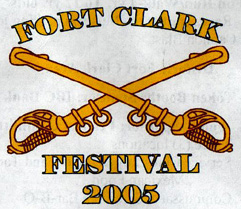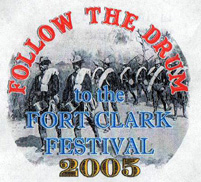|
History of Fort Clark and Surrounding Areas
Fort Clark was established
June 20, 1852 at Las Moras Springs by two companies of the First Infantry
under the command of Major Joseph H. LaMotte along with an advance and
rear guard of U.S. Mounted Rifles (later the 3rd Cavalry). Located at the
headwaters of Las Moras Creek, the spring, named "The Mulberries" by
Spanish explorers was a site long favored as camp grounds for Comanche,
Mescalero, Lipan, and other Indians.
During the late eighteenth and
early nineteenth century, the big spring was a stopping place on the
eastern branch of the great Comanche War Trail into Mexico. The original
site was s trip of 1 to 2 miles in width extending from Las Moras Springs
downstream about eight miles.
In 1849 Lieutenant W.H.C. Whiting,
during his reconnaissance for a practicable route between San Antonio and
El Paso, recongnized its military potential and recommended the location
as a site for a fort. The land was leased from S.A. Maverick. Two
Companies (C and E) of the First Infantry encamped near the Springs.
Later, the garrison was moved up the hill from the Spring. By 1853
quarters for the soldiers were nearly completed and in 1854 three
grass-covered officers' quarters were built. In 1855 a stone hospital and
a two-story storehouse were erected.
The Post was originally named Fort
Filey in honor of the commanding officer of the First Infantry, but on
July 15, 1852, at Riley's request, it was named in honor of Major John B
Clark, a deceased officer who had served in the Mexican War. A formal
military lease for Fort Clark was made on July 30, 1852, by Lt. Col. D.C.
Tompkins. With the onset of the Civil War and the secession of Texas, the
Federal soldiers left Fort Clark, March 19, 1861 and returned December 12,
1866. Until August 1862 the Fort was occupied by the Second Texas Mounted
Rifles. It later served as a supply depot and a hospital for Confederate
troops and civilians in surrounding areas. With the establishment of Fort
Clark, a neighboring settlement of Las Moras came into existence when
Oscar B Brackett established a supply village for the Fort. The town's
name was changed to Brackett in 1856, and later to Brackettville. The
stage ran through the settlement and for almost a century the town and the
Fort remained closely identified.
Fort Clark is perhaps most famous as
the home for the Seminole-Negro Indian Scouts. After twenty years of
protecting Mexico's northern states from hostile Indians for the Mexican
Army, they came to Fort Duncan in 1872 and to Fort Clark to serve the Army
as scouts. The Indian Scouts served at Fort Clark from 1872 until 1914.
Lt. John L. Bullis, later a general, served as their commander from
1873-1881. Fort Clark is also noted as the headquarters for Colonel Ranald
S. Mackenzie's raiders. He led raids into Mexico to punish renegade
Indians, playing a decisive role in bringing to an end the Indian
depredations in Texas. Comanches on horseback swept down from north on
moonlit nights, raiding, killing, taking horses, mules and cattle,
escaping across the Rio Grande into Mexico. Lipans and Kickapoos from
Mexico slipped across the border into Texas, destroying, stealing,
murdering, and returning quickly to safety. Outlaws of every nationality
fled from one side of the border to safety on the other side. Hundreds of
pioneers were forced to abandon their homesteads. |
On May 17, 1873
Mackenzie, accompanied by Lt. Bullis and the Seminole-Negro Indian Scouts,
led troops of the 4th U.S. Cavalry into Mexico on a punitive expedition
against the Lipans. Other sorties followed. Again in 1878, Mackenzie was
recalled to Fort Clark to stop the Kickapoos's was on Texas. Mackenzie
with Bullis and Seminole Scouts and a large peace-time army crossed the
border to effectively stop the Mexican Army and end the Mexican-Indian
hostilities forever. The last Indian depredation in the Military district
of the Nueces was in 1881. Many infantry units and virtually all cavalry
units, including the 9th and 10th Black "Buffalo Soldiers", were stationed
at Fort Clark at various times. During the Spanish-American War, Fort
Clark was garrisoned by the Third Texas Infantry. With the Indian Wars at
an end, the Fort was threatened with closure, but turmoil along the border
due to the Mexican Revolution revitalized the military need for the Fort,
as did the First World War, which soon followed. In 1941, the 5th Cavalry
was transferred to Fort Bliss and Fort Clark was then manned by the 112th
Cavalry, Texas National Guard Unit, until their deployment for combat
duties in the Pacific. Later, more than 12,000 troops of the second
Cavalry Division trained at Fort Clark until their deployment in February
1944. The war also added another feature to the history of Fort Clark,
that of having a German POW sub camp on the 4,000 acre reservation.
By the end of World War I, the
technological advancement of modern arms signaled the obsolescence of the
horse cavalry. Yet it was not until June 1944, that full mechanization of
the cavalry caused the government to close Fort Clark, one of the last
horse-cavalry posts in the country. The Fort was officially deactivated in
early 1946, and later that year was sold to Brown and Root Company for
salvage and later used as a guest ranch. In 1971, the Fort was purchased
by a private corporation and developed into a private recreation
community.
Today Fort Clark encompasses about
2700 acres. The spring feeds Las Moras creek and a dam also feeds the
water into a very large swimming pool with a year-round temperature of 68
degrees. Below the dam, fishermen, bird watchers, hikers, picnickers, and
campers enjoy the beautifully wooded Las Moras Creek banks. The Historic
District of the Fort remains much as it was planned and built I n the
1800's. The history is displayed by six dioramas created by members of the
Fort Clark Arts of the Old Fort Clark Guardhouse Museum maintained by the
Fort Clark Historical Society. Visitors at the museum are welcomed by
volunteer hosts and hostesses. In 1979, Fort Clark was entered on the
National Register of Historic Places.
Fort Clark is truly a
fort closure that became a success story, and is
"Living History
Today".
|

